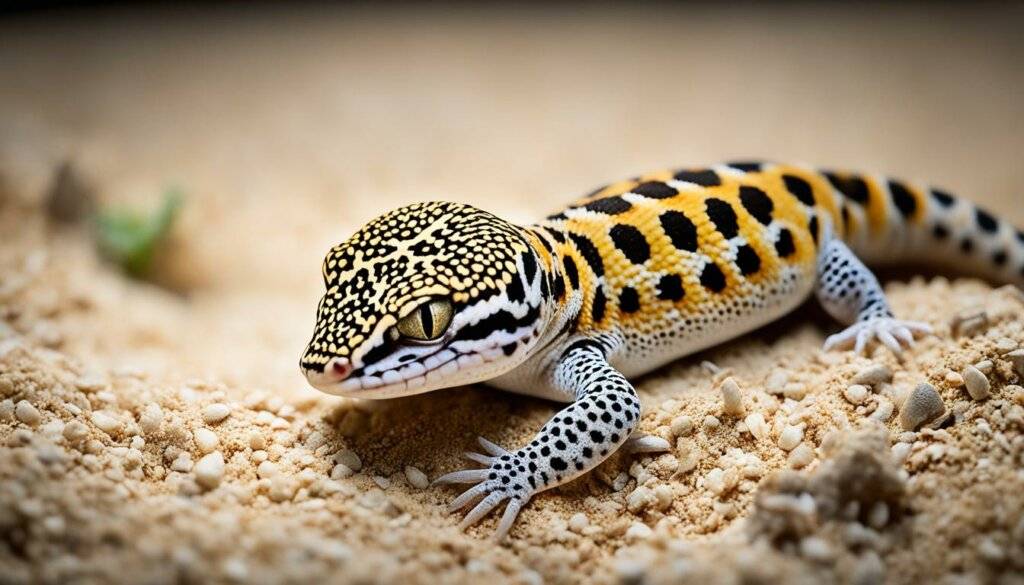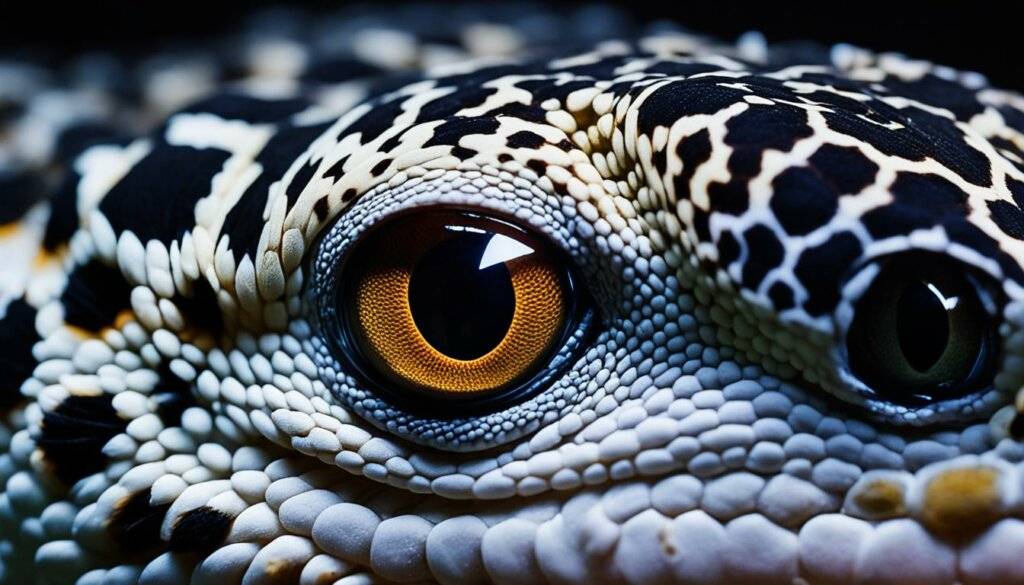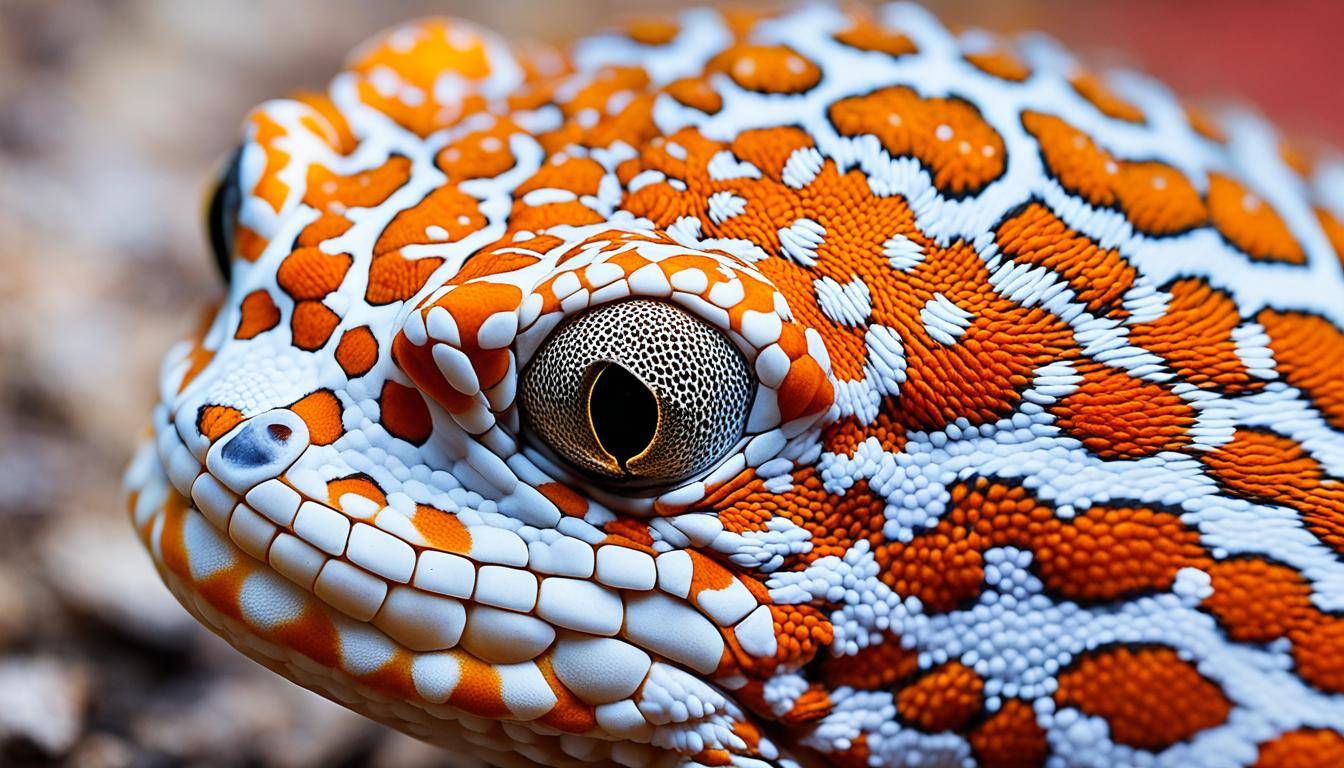Did you know leopard geckos are fascinating nocturnal creatures? They are most active at dawn and dusk, thanks to their nocturnal habits. Let’s discover what drives this behavior and its effect on their pet care routine.
Leopard geckos, known scientifically as Eublepharis macularius, became nocturnal to avoid predators and the harsh sun. They have great night vision, helping them hunt and navigate after sundown. Knowing about their nocturnal lifestyle is key to taking good care of them.
To take care of leopard geckos, respect their love for the night. A quiet, undisturbed place during the day is important for their sleep. Feeding them in the evening matches their natural hunting time.
Using natural light cycles in their tank makes them feel at home. It should be darker in the evening. A heat source in their tank mimics desert warmth at night. This keeps their body temperature just right, helping them stay healthy.
Stay with us as we dive further into the world of leopard geckos. We’ll explore their nocturnal nature and how it influences their life.
Why are Leopard Geckos Nocturnal?
Leopard geckos become nocturnal because they need to stay safe from predators and avoid the desert sun. They have developed this habit like many reptiles for protection. Their eyes work well in the dark, helping them see to find food and move around at night.
They are great at living in the dark, thanks to their sharp senses and special eyes. This helps them find food and move around easily at night. They stay active at night to escape predators and the desert’s extreme heat.
Leopard geckos’ nocturnal behavior is an evolutionary adaptation that has allowed them to thrive in the desert landscape, where the scorching sun and potential predators pose significant challenges.
Hunting at night helps leopard geckos save energy and water. This is crucial for surviving in their dry homes.
The Role of Predators
Predators shape how leopard geckos act at night. Being nocturnal helps them avoid daytime predators like birds and big reptiles. This way, they stay safe, find more food, and find shelter easier.
The Desert Sun and Thermal Regulation
The desert sun makes it tough for leopard geckos to control their body heat. Being active at night keeps them from getting too hot or dehydrated. They are most active at dawn and dusk when it’s cooler. This helps them stay at the right temperature without getting stressed by the heat.
We need to respect their nocturnal nature to take good care of them. Watching how they act and making their homes right ensures they stay healthy and happy.
Now, we will look at how their night habits affect their life. We’ll see how to adjust their care to fit their nocturnal ways.
The Impact of Nocturnal Behavior on Their Lifestyle
Leopard geckos are active at night, affecting their eating, sleeping, and general behavior. They sleep during the day, hiding in cool, dark places. When night falls, they wake up to hunt and check out their surroundings.
These activities show how they have adapted to living at night. Their amazing night vision helps them move and hunt with precision. Their nocturnal ways are shaped by their natural surroundings and the habits of their prey, which is also night-active.
Some may think it’s hard to look after these geckos because of their night habits. Yet, their nocturnal nature matches their need for insects like crickets and mealworms. Since these insects are night-active too, leopard geckos can follow their instinct to hunt and eat efficiently.
“Watching my leopard gecko hunt under the moonlight is truly fascinating. Their stealthy movements and lightning-fast strikes are a testament to their remarkable nocturnal adaptations. It’s a sight to behold!” – Jessica, leopard gecko owner
Leopard geckos’ night habits also shape their daily life and behavior. It’s important they sleep without disturbance during the day. They need quiet spots to hide and sleep well, like caves or fake plants.
It’s crucial to understand and respect their night habits to take good care of them. A habitat that suits their natural ways and lets them do their usual night activities is key. This ensures they stay healthy and happy.

-
Save
Behavioral Characteristics of Leopard Geckos:
- Active at night, sleeping during the day.
- Excellent night vision.
- Prefer cool, dark hiding spots for sleep.
- Emerging at dusk to hunt and explore.
- Feeding primarily on nocturnal insects.
By recognizing these traits, you can provide your leopard gecko with what it needs to do well. This helps create a strong connection with your interesting nocturnal friend.
Adapting Care Routine to Match Their Nocturnal Lifestyle
Leopard geckos are nocturnal, so their care needs to fit this lifestyle. They need special care to stay healthy and happy. It’s important to understand what they need.
Creating a Quiet and Undisturbed Environment: During the day, they need a calm place to sleep. Keep their area quiet and free from loud sounds. They should have hiding spots like caves or plants in their tank for peaceful rest.
Scheduling Evening Feedings: These geckos are active at night. Feed them in the evening to match their active hours. Give them a varied diet of insects in the evening.
Replicating Natural Light Patterns: Light is key for leopard geckos. Create a darker tank environment at night to mimic their natural habitat. Use dimmer switches for easy light control, matching their night-time needs.
Providing a Heat Source: They like it warm, similar to their desert home. They use the night’s warmth from rocks and sand. Make sure they have heat in their tank, like heating pads or lamps. This keeps their temperature just right.
Adapting care to their night lifestyle is crucial. Ensure they have a quiet place for day sleep, feed them at night, use dim lights to reflect natural patterns, and provide warmth. This care supports their instincts and well-being.
Facts at a Glance:
| Leopard Geckos’ Nocturnal Care Routine | Recommendations |
|---|---|
| Create a Quiet Environment | Provide hiding spots for uninterrupted rest |
| Schedule Evening Feedings | Offer a balanced diet in the evening |
| Replicate Natural Light Patterns | Ensure darker conditions in the evening |
| Provide a Heat Source | Use under-tank heating pads or heat lamps |
The Importance of Observing Nocturnal Behavior
Watching leopard geckos at night is key to keeping them healthy. By observing their habits, you learn about their health. This can help spot stress or sickness early.
If a leopard gecko changes its sleep habits, it may be unwell. When they sleep too much or can’t rest well, it’s a worry. A regular sleep schedule is vital for their health.
How active they are at night also matters. They are usually lively in the evening. If they’re less active or seem tired, there could be a problem. This might show health issues or stress.
It’s important to watch what they eat too. Leopard geckos need specific foods. Changes in how much they eat or if they refuse food can signal stress or illness. Eating more could mean their diet needs to change.
Each leopard gecko is different. Knowing their nightly habits helps you understand them better. This lets you spot any unusual behavior quickly. From there, you can deal with any problems right away.
Benefits of Observing Nocturnal Behavior:
- Early detection of health issues: Watching their behavior helps find stress or sickness early. This means they have a better chance of getting better.
- Improved well-being: By keeping an eye on their activity, sleep, and eating, you help keep them healthy.
- Reduced stress: Solving problems in their living space makes it more comfortable for them.
- Enhanced bond: Regularly watching them helps you get to know their unique behaviors. This strengthens your bond.
Creating a strong bond with your leopard gecko comes from trust and understanding. By closely watching their night behavior, you give them the care they deserve.

-
Save
Conclusion
Knowing how leopard geckos act at night is key to good care. They are active after dark, which shapes their needs for happiness and health.
To support them, make their home feel like their natural environment. Feed them in the evening and let them rest quietly during the day. Make sure their home has the right light and temperature.
Keep an eye on how they sleep and move, and when they eat. Changes can mean they are stressed or sick. Watching them helps you spot any problems early.
It’s important to look after leopard geckos’ night-time habits. With proper care and the right setting, they will be happy and healthy pets.
Fostering a Healthy Nocturnal Environment
To create a perfect night space for leopard geckos, ensure their tank is cozy and secure. It should have hiding spots like caves or plants. These spots provide comfort and mimic their natural settings.
The tank must also have the right substrate and hiding places for shedding. Proper lighting and temperature help them keep their natural routines. This encourages better health.
Leopard geckos do well when their night-time habits are supported. A big tank lets them explore and stay active. Having hiding spots helps them feel safe, especially when under stress.
Their habitat should look similar to what they have in the wild. The right substrate, like reptile carpet or paper towels, keeps their space clean. Hiding spots are a must for when they shed their skin. This keeps them safe from injuries during shedding.
Keeping the right lighting and temperature is key for their well-being. A light that follows the day-night cycle is best. They need a warmer and a cooler side in their tank to regulate body heat.
By creating a good nocturnal environment, leopard geckos will thrive. The right tank conditions make them feel secure. This allows them to act naturally and stay healthy.
